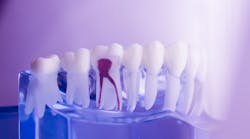As comprehensive as my education was, I knew nothing about D4910 (periodontal maintenance procedures) when I started my first job. I was told by one of the business team members that it was an insurance code, and they’d handle it. I accepted this at face value. I had enough on my plate trying to navigate the transition from school to practice, and this gave me some relief in that I wouldn’t be struggling to figure it out.
I eventually learned that CDT codes are not “insurance codes.” It is true that insurance is one of the areas in which coding is used, but the codes are “procedure codes” set up by the American Dental Association (ADA). The purpose of a code is to “achieve uniformity, consistency, and specificity in accurately documenting dental treatment.”1
As health-care providers, it is our responsibility to ensure that the procedures we’ve performed as licensed professionals are reflected correctly. It is unreasonable to think that a team member who was not part of the treatment can accurately record what was done. Additionally, a code is part of the patient’s electronic health record laws and the HIPAA (Health Insurance Portability and Accountability Act) requirements to which we are bound as licensed professionals.1
It is fraudulent and unethical to code according to what a patient’s particular insurance plan covers or does not cover. That conversation is between a patient and their employer with whom the details of the policy have been negotiated with the dental insurance company. Further, dental insurance is not designed to be all encompassing. It is considered a supplement, and we all know that consenting only to what is covered can result in the need for more costly dental treatment in the future.
Our job is to recommend appropriate care, work with the business team to determine out-of-pocket costs so the patient is fully informed, and accurately code for the consented procedures performed.
Another area that can often be a pain point regarding periodontal maintenance: it is common for patients to question the maintenance procedure. To them, the procedure may feel like the hygiene visits they’ve always experienced, but now there is a higher out-of-pocket cost.
Related by Julie Whiteley:
How to increase patient commitment to periodontal treatment
What to tell patients
These tips can help eliminate some questions around periodontal maintenance procedures and increase the value of these appointments.
1. Know the nomenclature of the code.
Understanding the specific description for each code (the nomenclature) allows for more consistency and clarity when determining and communicating treatment. Periodontal maintenance follows periodontal therapy (either scaling and root planing procedures, gingival flap surgery, or osseus surgery). The procedure is therapeutic in nature and the intervals can vary based on clinical evaluation. The procedure consists of removing pathogens (not just calculus, but biofilm) from both supragingival and subgingival to the CEJ (cemento-enamel junction). It also includes site-specific areas of scaling and root planing if necessary. The goal of the treatment is to stabilize and control previously treated periodontal disease.
The following suggestions will address establishing a separate process of care for a periodontal maintenance appointment versus the process of care for a prophylaxis. These are two very different procedures, with one being routine and the other being therapeutic, and the appointment should be managed as such.2
2. Evaluate and document the periodontal charting at each visit.
According to the American Academy of Periodontology (AAP), periodontal charting should be completed on adult patients a minimum of once per year, and includes six-site probing, calculation of clinical attachment loss, bleeding, suppuration, furcation involvement, mobility, and recording any areas of thin or absent attached gingiva.3 (Periodontal charting may be indicated at a younger age based on individual patient history and presentation.)
Periodontal maintenance requires close monitoring, and the periodontal condition should be evaluated at each visit to determine if active disease is continuing or worsening despite treatment. Periodontally involved patients should be staged and graded according to the 2018 AAP classification system.3
A summary of the gingival description, which can be supported by taking a few photos, can also provide more thorough documentation and can act as a reference point as you make assessments at subsequent visits.
Appropriate treatment and/or referral for additional evaluation and intervention must be determined based on the findings of your periodontal assessment. If the patient is not maintained (the disease is continuing or worsening), or you find yourself doing more than localized scaling and root planing, the visit is no longer a “maintenance” visit and does not fit the nomenclature of the code. Further, failure to inform a patient of the status of their nonstable or worsening condition constitutes supervised neglect. Depending on the case and discussion with your dentist, retreatment and/or referral may be indicated.
3. Capture bone height in radiographs.
Radiographic comparison over time is a useful diagnostic tool to monitor the disease, but bone height is often missing in the horizontal bitewing on the periodontally involved. Due to the angulation, bitewings are a more accurate reflection of bone height than periapical films. Consider the position of the bone height of your periodontally involved patient and expose vertical bitewings to best capture the bone of both arches. The frequency of the radiographs taken should be based on individual risk factors and clinical presentations. The ADA prescription guidelines are a helpful resource.4
4. Assess the plaque/biofilm/calculus present.
The goal of nonsurgical periodontal therapy is to minimize risk factors to eliminate or control active disease. More successful outcomes can be better achieved with a partnership between regular therapeutic visits with the hygienist and an effective and consistent home care regimen for the patient. Documenting and reviewing with the patient the amount and location of deposits present can assist with that goal.
Disclosing solution (particularly a formulation that can show the difference between new and old plaque) is a helpful tool not only for periodontally involved patients, but also those who present with less than adequate home care. Home care recommendations for your periodontally involved patients should aim to address specific areas of concern given the fact that the patients often present with more complicated tooth anatomy and cleansing challenges than patients who have not experienced attachment loss. Recommendations may consist of water flossers with periodontal adapters, interdental brushes, rubber tips, end tufted brushes, and similar devices.
5. Customize the treatment to a periodontally involved patient.
The goal of the treatment is to reduce the pathogens that repopulate in the sulcus. Frequent mechanical removal is an essential component of periodontal therapy.
Following periodontal instrumentation, the subgingival pathogens repopulate to preinstrumentation levels in about nine to 11 weeks in most patients. Treatment is best completed with a combination of power scaling and manual instrumentation. The longer and thinner tips provide for better access. The water provides a lavage effect, and the vibrations provide acoustic turbulence that disrupts bacterial cell walls.5
Given the complexity of root anatomy and navigating deep pocket depths, I recommend perio instruments (thin power scaling inserts, minis, after 5’s, diamond perio files for furcations, etc). There is also a significant amount of evidence supporting the use of air polishing (after proper training on use and indications) in biofilm management.
Treatment of periodontal maintenance patients may also involve localized areas of scaling and root planing and some patients may require a form of local anesthetic and/or desensitizing agent for a periodontal maintenance procedure.
Periodontal disease is multifactorial in nature, and it is important to understand the individual risk factors for each patient. Thorough review of health history, social history, parafunctional habits, examination of intra- and extraoral hard and soft issues, current periodontal evaluation, and assessment of factors such as inflammation and home care are necessary to properly assess, plan treatment, and monitor outcomes. Further, these modifications to routine/nonperio involved appointments can assist patients in seeing and understanding the nature of their treatment and how it differs from a typical hygiene recare visit.
References
1. Code on Dental Procedures and Nomenclature (CDT Code). American Dental Association. https://www.ada.org/en/publications/cdt
2. Armitage GC, Xenoudi P. Post-treatment supportive care for the natural dentition and dental implants. Periodontology 2000. 2016;71(1):164–184. doi:10.1111/prd.12122
3. Periodontology. American Academy of Periodontology. https://www.perio.org/
4. Dental radiographic examinations: recommendations for patient selection and limiting radiation exposure. American Dental Association. Revised 2012. https://www.ada.org/~/media/ADA/Member%20Center/FIles/Dental_Radiographic_Examinations_2012.ashx
5. Gehrig JS. Fundamentals of Periodontal Instrumentation and Advanced Root Instrumentation, 8th Edition. Wolters Kluwer Health/Lippincott Williams & Wilkins. Philadelphia, PA.
Julie Whiteley, BS, RDH, is certified in human resources and holds degrees in business administration and dental hygiene. She is currently a patient care advocate for an oral health and wellness center focused on prevention and increased access to regular dental care. Julie is on the faculty of Massachusetts College of Pharmacy and Health Sciences University. She bridges her knowledge and experience from business, clinical hygiene, and teaching to deliver information and programs that promote comprehensive patient care. Contact her at [email protected].







